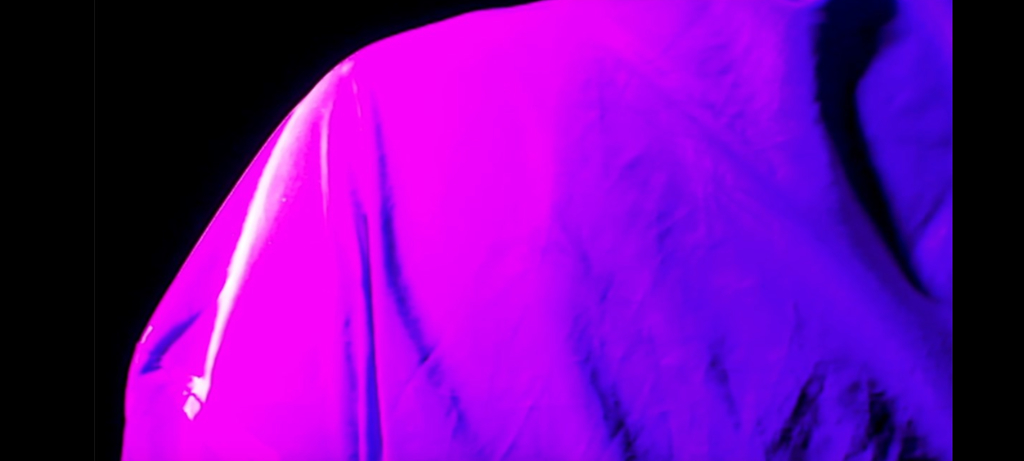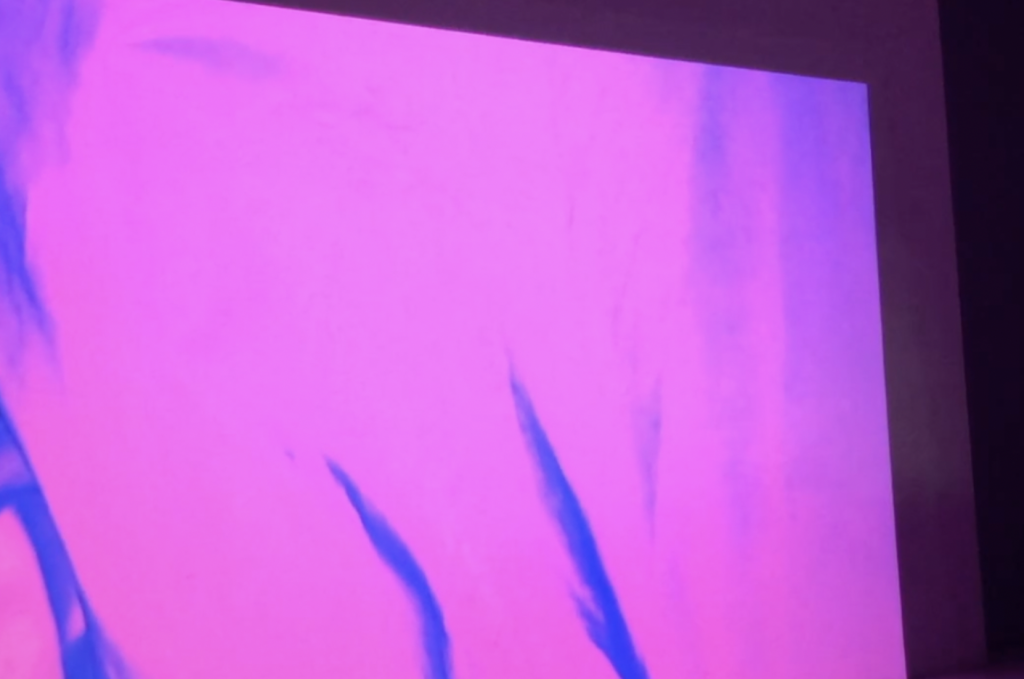Interview by CLOT Magazine

The exhibition Proximity Music: Sensing After Thought, curated jointly by Rewire and iii – an artist-run community platform supporting new interdisciplinary practices linking performance, technology and the human senses that contribute to international developments in the field of Art, Science & Technology-, used the idea of interruption to enter a discourse on different states of human sensing, being and perceiving the world.
One of the artists participating was Angelo Custódio, an artist originally from Portugal who works with voice and performance. He creates sonic-based experiences which address the body and vulnerability from a crip/queer perspective. Within the program of Proximity Music: Sensing After Thought he presented his new work HUM (an/other), an immersive participatory installation expanding listening through touch and artificial intelligence.
A machine learning system reacting to visitors processes the artist’s voice. Visitors were invited to place a custom-made tactile transducer on their own bodies, merging themselves with a hybrid organism. HUM (an/other) was presented in collaboration with Das Leben am Haverkamp at Stille Veerkade 19.
We discussed different aspects of the festival’s artistic programme theme and the artwork he presented.

In relation to the Rewire 2022 art programme/exhibition’s theme, how are any intuitive processes in your practice or, on the contrary, ways to approach your practice more calculatedly, impact or balance in your practice? And what role do interruptions and afterthoughts play as well?
This complex question brings forward the relational aspect of ourselves as beings and our processes of creating/making. It addresses how the work comes into being in dialogue with me as a person.
Intuition or gut feelings are important and an ongoing part of my practice. Their rawness and messiness punctuate the moments I experiment with writing or improvisation with voice and performativity. Most of my methodologies of making engage and research different modes of listening. In this sense, embodied practices, more or less related to singing, such as Gyrokinesis, destabilise and inform these experimentation moments and the more analytical making sense of things that intertwines my creative processes.
They prompt my creativity and thinking and are intrinsically part of my ongoing search, a not-knowing as part of my research engagement. For me, desire, body and lived experience are other ways of knowledge production that (un)balance or destabilise the more organised or academic ways of understanding the world. They function as non-linear events that bring a sense of disorder, like Jack Halberstam would mention, to the more fixed ways of knowing propagated by language as technology, for example. I would like to point out the ‘closeness’ of the meaning of the words disorder and disability spread by the medical model.
As an artist, I also assume a destabilisation positioning in this sense. And I don’t even think this was a conscious choice. But as you might understand, being a person with a hypervisible disability already interrupted the idea of the normative body in the normative gaze. Thus interruptions by less familiar elements that might disorient from a fixed positioning/understanding of something and that might open up for an afterthought are clear strategies you can sense when experiencing my work.
We cannot avoid thinking per se, but we can allow other relational and embodied processes of feeling/sensing the world to inform (and decolonise) the ways we perceive, think, do and are/become.
What is your relationship with the machines or instruments, the stochastic nature of algorithmic processes and if these figure in your artistic practice? if so, how do you approach the chance, unpredictability, and loss of ownership when working with the machine?
To include improvisation as a methodology in practice implies being in the moment with someone else (machinic or not) and all others within. This dialogue as a methodology of making implies already a loss or, in other words, shared authorship. I am not interested in the idea of the single-minded person/individual/artist, especially when thinking and acknowledging the world from a crip/queer understanding, in which notions of relationality and interdependence come into play.
Obsessions for control and patriarchal power dynamics are embedded in our structures and how we work and relate to one another. To which means these are used, and what for, are recurrent topics of my work, especially about whose bodies are valuable and why.
Talking about letting go of control and embracing chance, the Aria of Cage might have been the most fun encounter with a score I had during my background as a singer. Understanding a score as an open structure for improvisation, or unpredictability, totally metamorphosed my understanding of the score and is the basis of my work.
In my work HUM(an/other), I wanted to develop an intimate encounter with an AI entity. Encounters are non-linear events, alive and vibrant. Being surprised by the unexpected and what that prompt is just ‘magical’ for me. So I am not interested in fully controlling my work’s ‘final’ result, even when collaborating with a machine. My collaborators (Tatiana Rosa and Pedro Matias) and I were often surprised and excited by the compositional decisions of the machine (which we call Proxima). I also wonder about the purity of the ‘randomness’ of these processes when we know that learning algorithms are developed about the human mind.
Even though the arts programme was based in Amare some works will be distributed outside on the streets in den Haag; what are your thoughts towards the urban landscape in a city of a post-pandemic reality, and how do you think your works incorporate the thinking about the public space and physical proximity? i.e. referring to the exhibition title. What is your afterthought in the aftermath of the pandemic?
I think of intimacy as the aftermath of vulnerability. With or without technology, but definitely, with an embodied component, we won’t be able to understand and acknowledge each other as people if we do not allow this in our social spaces. The possibility of sharing physical space does not necessarily allow for meaningful encounters. The level of intimacy shared in an encounter is mediated by allowing oneself to be vulnerable.
We all know we have not been socialised towards this kind of relationship. But moreover, the risk is usually high; thus, one complies once more with the performativity of patriarchal sociality. Or one is aware of it and engages in patterns of consumption (even of people).
So I think people are craving proximity, especially after a moment like the pandemic. Still, we don’t culturally inherit the means to navigate it or prioritise it in our societies. So I guess I try to open up this kind of liminal space with my work, and at Rewire, I used technology to do so. But I think we, as people, need to work on being intimate with ourselves first to accommodate others. So in the aftermath of the pandemic, this is my afterthought: the need to be in touch with oneself.
Rewire 2022 arts programme explored embodied experience in contrast to disconnected thinking. What are your approaches to affect and physical presence in your practice and the role sound has in augmenting the virtuality of the mind with the experience of the physical in general?
Sound is precisely the first layer of my work. How voice, for example, is embodied, emerges and emanates from an operatic body to affect others was my departure point to thinking and understanding sound as material. Resonance is an invisible material that touches and travels through our bodies, carrying flows of affect.
This vibratory phenomenon challenges the body/mind separation and destabilises many binaries in the language used to categorise things. It brings forward notions of fluidity, vulnerability, failure, and contradiction, to name a few. We are all those in an ever-shifting complex body/world relation. This understanding challenges preconceived ideas of what it means to be human and its multiple overlapping dynamic processes of individuation.
I am not interested in creating a disembodied immersive overload in my work. In HUM, I used vibration to ground the experience of the work – a strategy of using touch and being in touch (with oneself). This carries flows of sonic affect, but it also grounds the experience of the work through somatics. This was quite important for me since I am bringing forward sensitive connections to our individuation processes in the work context. I guess I am more interested in creating relational experiences that are less organised or that you cannot make sense of immediately, but that instead unfold in time as non-linear interruptions.
About the new work ‘HUM (an/other)’, what is your relationship with the machine, and how do you think interaction with artificial intelligence or any kind of machine models in your artistic practice has influenced your physical presence and also the participation and proximity and among Rewire festival’s audiences? How can technology help us tackle vulnerability?
I usually put myself in a vulnerable place as a performer, so I open up the possibility of it existing in the performative moment. Ephemeral as it can be, the generosity of opening up to it and bringing it forward allows the audience to let go and open up slowly.
My purpose with this particular work was to use technology towards an intimate encounter between machine and self, relating embodied and mechanic surveillance and its impact on who we are and continually become. I was particularly interested in using technology already used for surveillance and addressing how it might codify our (embodied) ways of thinking and being. I put it in relation to the gaze as surveillance embodied technology.
I wanted to comment upon how these processes feed our fear of the unknown and how they are used for control and capital development – a healing direction in resonance with self rather than a technofetishised future. Perhaps I am trying to create a space for an active process of opening toward vulnerability mediated by a machine? – I ask myself. So for me, it also made total sense to give away most of the control of what people experience to the machine and to open up myself towards a kind of artistic vulnerability.
Nevertheless, I don’t think I have already tackled this question in my work HUM (an/other), but I hope to do so in the following research step. I will understand better the influence of using AI on my physical presence once I work towards a live moment, which was the original idea of this research. This next step will include the same AI camera incorporated into my body. The idea would be that encountering bodies in space, through camera detection, would process and destabilise the live sound being produced by Tatiana and I and relate sonically to the notions of encountering and instability.






